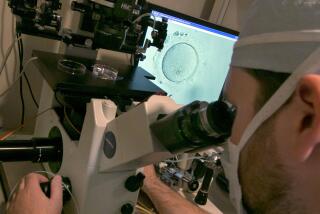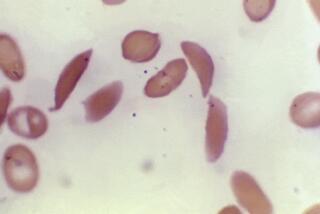Baby 1st to Receive Gene Treatment : Medicine: Childrens Hospital team uses the therapy on a newborn in historic surgery. Doctors hope to cure his rare immune disorder before disease sets in.
- Share via
Andrew Gobea cannot possibly know it, but on Saturday he made medical history. The procedure, which took place behind a plastic curtain in a sterile room at Childrens Hospital Los Angeles, lasted just two minutes. Andrew, four days old, slept through it all, his tiny fingers curled under his right ear, a look of peaceful repose on his face.
The 6-lb., 12-oz. baby with thick black hair and hands that his dad says are destined to make him a baseball pitcher was born Tuesday evening with an immune system that does not work. On Saturday, a doctor infused the infant with a teaspoon’s worth of genes that are intended to cure the disease that, if left untreated, kills most of its young victims by the time they would reach their first birthday.
The treatment makes Andrew the first newborn ever to undergo a leading-edge brand of medicine known as gene therapy. It also employs, for the first time, a novel twist on previous attempts at genetic engineering: the use of blood drawn from the umbilical cord that was snipped from the baby at birth.
For Andrew, the highly experimental operation means a chance to live a normal life, without drugs that cost as much as $250,000 a year. For his parents--who three years ago lost an infant daughter to severe combined immune deficiency, the same disease that plagues their newborn boy--it means the chance to raise the child they have dreamed about for so long.
For a team of four pediatric immunologists and hematologists at Childrens, Saturday’s effort was the culmination of six years of painstaking investigation, of late nights in the laboratory and frustrating wrong turns and finally, the rare, heady rush that comes when science moves out from under the microscope and into the operating room.
And for thousands of other infants who will be born with genetic disorders that can be diagnosed in the womb--hemophilia, sickle cell anemia and Gaucher’s disease, among others--it represents a step toward treatment immediately after birth, and hence freedom from the debilitating effects of those diseases.
The occasion was as emotional as it was revolutionary. When Leonard Gobea asked if he could help inject the gene-altered cells into his son, Dr. Donald Kohn took the unusual step of allowing him to press on the syringe, which was attached to an intravenous line. “It’s not rocket science,” the doctor said afterward. “It’s just pushing a little plunger. He wanted to be a part of doing it, and I thought that was great.”
It will likely be another six months before doctors know if Andrew’s treatment has worked. During that time, he will also be given twice-weekly injections of a drug containing an enzyme to shore up his immune system. Until doctors are certain that drug is working, he will remain in isolation at Childrens.
“We wear two hats,” said Kohn, the gene therapy expert who headed the experiment. “We want to do the right thing for our patients, and we want for this family to have a healthy baby. But we’re also researchers, and we want to further our research goals.”
It was those two forces--the hope of Crystal Emery and Leonard Gobea to have a healthy baby, and the desire of Kohn and his colleagues to push the limits of the gene therapy--that set the couple and the doctors on a collision course that began months before Andrew’s birth.
They are young, Emery and Gobea. She is 19 and he is 20. They are not married. She lives with her parents in the Imperial Valley town of El Centro; he with his parents in Holtville.
He is a part-time steam driller and sandblaster who dropped out of high school. She wears a small diamond on her left ring finger, but marriage and a home of their own must wait, Gobea said, until he gets better situated with a job.
They have been dating since they were in junior high, and after all these years they say they might as well be husband and wife. They had their first child--a planned birth, they are quick to say--when they were 16 and 17.
Why? “I just want a baby,” Emery said simply. “I don’t know--you can’t put something like that in words. But just to know that a little baby depends on you, you get to take care of it, it loves you.”
Chastity Gobea lived five short months. The first sign she was sick came at age 2 weeks, when her umbilical cord would not heal. Then there were two bouts with pneumonia. By the time doctors discovered her genetic disorder, it was too late. She is buried in El Centro, in a cemetery called Evergreen.
Her father wears her name tattooed in black letters on his left hand. “I still have a lot of trouble understanding about Chastity,” he said sadly.
Her death brought news to her parents: each carries a defective gene that causes ADA deficiency, a form of severe combined immune deficiency (SCID). The letters ADA stand for adenosine deaminase, an enzyme that enables the immune system to fight infection.
Emery and Gobea each have one gene that manufactures the enzyme, and one that does not. In one of those unfortunate quirks of genetics--the odds were one in four--Chastity was born with two defective genes. So was Andrew, although he was helped in a sense by his sister’s death because doctors knew enough to test him in the womb.
SCID is extremely rare; each year just 100 Americans are born with the disease. The most famous victim was David, the “boy in a bubble,” who lived in isolation in a Houston hospital for 12 years before his death in 1984. ADA deficiency is the most common form of SCID, accounting for 25% of all SCID cases.
The drug used to treat the disorder, which was approved for use three years ago, is expensive--weekly or twice-weekly shots that cost about $2,200 each--and does not always work. Bone marrow transplants are also a common treatment, but they too are not always successful. Chastity Gobea died after receiving one.
So scientists have been concentrating on another route: gene therapy.
Gene therapy is still in its infancy. Just 47 gene therapy projects, most of them designed to treat cancer patients, are now either approved or under way worldwide, according to Dr. W. French Anderson, a USC geneticist who is a pioneer in the field.
Although the technology for gene therapy is sophisticated, the techniques remain crude. Most gene therapy experiments employ a class of viruses known as retroviruses to carry missing genes into target cells. But scientists have yet to perfect methods for transferring the genes into cells, and once inside, the genes do not always work.
ADA deficiency lends itself well to gene therapy, primarily because the disease can be corrected with just a small percentage of functioning genes. The world’s first approved gene therapy experiment--conducted in 1990 by Anderson and Dr. Michael Blaese at the National Institutes of Health--was performed on two ADA-deficient girls, ages 9 and 4, who had been treated with experimental drugs before the therapy.
The experiment on Andrew Gobea is being conducted in conjunction with NIH. Blaese, who was present Saturday, agreed to serve as a collaborator so that the government would give the experiment emergency approval in time for Andrew’s birth. In conjunction with San Francisco doctors, the team will repeat the procedure early this week on a baby boy born Friday in that city.
Andrew’s drama began Tuesday, at 6:25 p.m., at the Hospital of the Good Samaritan, just west of downtown Los Angeles. There, in a peach-colored room on the eighth floor, Emery gave birth to Andrew after five hours of labor, with one quick pelvic push.
Right away, the obstetrician snipped his umbilical cord and began drawing blood. It was crucial that as much as possible be obtained. Kohn and his colleagues were hoping for 100 cubic centimeters--about four-tenths of a cup. They got half that.
“I did the best I could,” Dr. Kathryn Shaw, huffing and puffing, told Kohn and Dr. Kenneth Weinberg as she handed them a rack of a dozen test tubes, only four of which were filled. “I stomped on it, wrung it out, hung it up to dry. Literally.”
If the doctors were disappointed, they refused to show it. After a quick peek at the baby as he was being cradled in his father’s arms, they sped back to their lab with the test tubes.
“Congratulations,” a colleague said. “You are now the proud fathers of 50 ccs of blood.”
Kohn, Weinberg and the others could have waited until Andrew was several months old to obtain blood from his bone marrow. But extracting the marrow would have been painful for Andrew, and using umbilical cord blood meant the therapy could take place immediately.
With the blood drawn, a long night of laboratory work lay ahead, as technicians began the intricate process of isolating Andrew’s “stem cells”--the parent cells of all other blood cells. For weeks, they had been practicing on a prototype machine borrowed from a Seattle-based firm, 17 practice runs in all.
Most gene therapy experiments target white blood cells; the therapy must be repeated every several months when the white cells carrying the new gene die. But stem cells stay alive in the marrow, continually spawning new cells. Thus, if Andrew’s therapy works, he will be cured.
But experts say the process is fraught with obstacles. Stem cells are very rare in the blood, comprising less than one-tenth of 1% of all blood cells, and are difficult to isolate. And for reasons that scientists do not entirely understand, genes introduced into stem cells do not function as well as those introduced into white blood cells.
It took Childrens Hospital technicians nearly six hours of careful, intense work to separate the stem cells from the rest of Andrew’s blood. They began with 500 million blood cells and ended with 3 million--a tiny pellet at the bottom of a test tube. But the number of true stem cells remains a mystery to the doctors, part of the guessing game that made Saturday’s experiment just that--an experiment.
Once the cells were isolated, there were two more additions to the genetic brew: a mouse leukemia virus that had been altered to contain the ADA gene, and “growth factors” to help the cells divide.
At midnight, the mixture was put in an incubator, where it spent the rest of the week, waiting for Andrew.
In the meantime, Emery and Gobea were getting to know their new son. He has his father’s feet, they decided, and his grandfather’s nose and little black sideburns that they think make him resemble Elvis.
At 1:04 p.m. Saturday Kohn suited up in a mask and surgical gloves and yellow hospital gown to inject the gene-altered blood into an intravenous line in Andrew’s right foot. Andrew’s parents watched tearfully. The father told the doctor that he hoped the procedure would work. “We probably won’t know until he is crawling,” Kohn replied.
Now Andrew’s blood will be checked weekly to see if the drugs are working and if the genes are turning up in new cells.
“I just want to take him home,” Gobea said, “and get him ready to throw a ball.”
Gene Therapy Experiment
Doctors at Childrens Hospital of Los Angeles performed a gene therapy experiment Saturday that marked two firsts: The first time a baby has been a gene therapy patient, and the first time umbilical cord blood has been used in such an experiment.
Here is how it worked:
1) Andrew Gobea is born Tuesday at 6:25 p.m. at the Hospital of the Good Samaritan. Obstetrician snips umbilical cord, draws blood from the cord and deposits it in four test tubes. Doctors from Childrens Hospital take tubes of umbilical cord blood back to their laboratory.
2) Laboratory technicians transfer blood into flask and mix with antibodies that bind themselves to so-called “stem cells,” the parent cells that give rise to all other blood cells. The antibodies attach to a protein called CD34 on the surface of the stem cells.
3) The blood is run through a special machine that separates CD34 cells from other blood cells. Only a small portion of the cells--3 million of a total of 500 million--have the CD34 protein. And only about a tenth of those CD34 cells are true stem cells.
4) Laboratory technicians add two substances to the CD34 cells--a mouse virus that has been altered to carry a gene that will correct Andrew’s immune deficiency, and three “growth factors” designed to help the cells grow and divide so that the virus can “infect” them with the genes.
5) The mixture is put in an incubator for three days, during which doctors hope the virus that carries the gene will infect the stem cells.
6) On Saturday, Andrew is given the new cells intravenously. It will take up to six months for doctors to see whether the stem cells have spawned other cells that carry the correct gene, and whether the gene is functioning properly.






